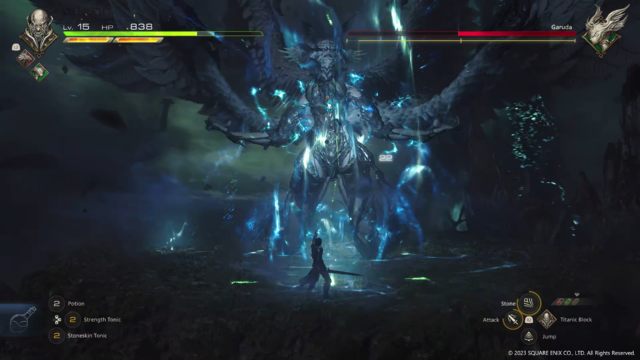
Square Enix
In so many ways, Final Fantasy XVI wants you to abandon everything you know about the franchise. It’s an action RPG with a heavy emphasis on the “action” part, built around only one playable character. It’s a darker, more violent story that, by the developers’ own admission, draws more from fantasy blockbusters in the West. And it’s seemingly trying to deliver the type of game a modern audience expects. While each entry in the series has tried something new, Final Fantasy XVI is arguably the biggest departure thus far.
After getting a hands-on with a preview demo—and talking to the creative business Unit III development team about the story, structure, and content of the game—the series diehard in me is starting to make out the vision being constructed here. Final Fantasy XVI is a bombastic, aggressive spectacle with prestige-level production values and a striking, self-serious vibe. But more than anything, the playable demo has me largely convinced that this new gameplay formula is actually the right move for the franchise.
[Disclaimer: Square Enix asked us to specify that this preview demo was a special version made for the media to experience and content may differ from the final version.]
A new kind of Warrior of Darkness
The preview demo featured well over an hour of combat-focused gameplay in two different scenarios—the first being a dungeon-like raid on a castle that ended in a story-critical boss fight. Just a few minutes in, Final Fantasy XVI combat director Ryota Suzuki’s previous experience designing Devil May Cry V was immediately apparent.
As protagonist Clive, you wield various Eikons (traditionally known as Summons) as if they’re different weapons or movesets. You execute special abilities tied to those Eikons by switching between them on the fly during real-time stylish-action combat, a distinct departure for the series that has been either turn-based or had more methodical action-RPG systems.
In this demo, I had Ifrit, Titan, and Garuda available, and once I grasped how to mix and match their attacks, I understood the possibilities in combat with combo strings, air juggling, and some well-timed execution bonuses.

Square Enix
Each Eikon also had a magic projectile and a positional “utility ability,” such as pulling an enemy toward you, closing the gap on a target, or blocking to mitigate incoming damage. With all these mechanics in my grasp, I could string together some fancy combos, dancing around the battle arenas untouched. For instance, I might use Garuda’s Wicked Wheel to launch an enemy into the air, execute her multi-hit Gouge, then pull the enemy toward me again before switching to Titan or Ifrit to land a powerful attack and keep the combo going.
You’ll have to consider staggering stronger enemies to leave them more vulnerable, breaking their Will Gauge by landing multiple powerful attacks or catching them off-guard. This feels very similar to the stagger system in Final Fantasy VII Remake.
Eikon abilities are subject to cooldown timers, so lining up your attack rotation is key, and experimentation is part of the fun. The upgrade skill tree also features explainers that outline the conditions in which you can effectively use each ability, helping to guide your strategies. There’s even a training mode Suzuki himself has likened to that of a fighting game, complete with command input data to help perfect your combos.
Furthermore, a Limit Break lets you build up in combat, which sends Clive on a damage-dealing frenzy (much like God of War’s Spartan Rage), and it’s worth working it into your flow.
All of these mechanics were key when fighting the dangerous miniboss duo Suparna and Chirada, which also showcased some of the combat’s cinematic flair. In these fights, I saw some DNA of Final Fantasy XIV in the way their spells were telegraphed in the arena with familiar area-of-effect markers on the ground.

Square Enix
Once I reached the top of the castle, it was time for a boss battle against Benedikta, one of Final Fantasy XVI’s core characters. She herself wields Garuda, helping to imbue the fight with heightened cinematic spectacle. She darts and weaves around the combat arena, testing your dodge and parry timing while challenging you to get hits in at opportune times.
Camera cuts between the fight’s phases seamlessly merge cut scenes and gameplay, all in-engine and rendered in real time. And simple quick-time events (through button prompts) accent key moments in these scripted sequences.










